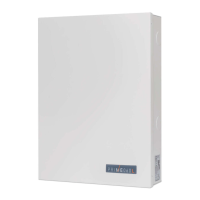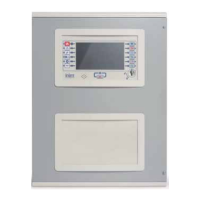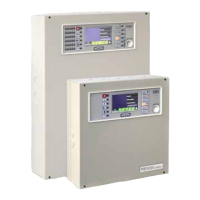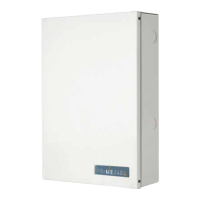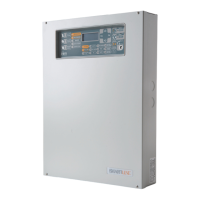Installation manual
Installation 45
3-6-1
Normally closed (N.C.)
In this case, the alarm condition is revealed exclusively by the number of pulses (pulse count)
the control panel detects on the terminal.
If this balancing method is applied, the control panel will be unable to detect tamper, wire-
cutting or short-circuit.
The discriminated conditions are:
• standby
•alarm
The alarm condition is detected exclusively by the pulse count and sensitivity, in accordance
with the programmed parameters (refer to the Programming manual, paragraph 6-1 Zonas/
Entradas, Detector type).
3-6-2
Single balancing (N.C. with EOL)
In this case, the discriminated conditions are:
• standby
•alarm
• tamper (wire cutting)
• tamper (short-circuit)
For each of these, the control panel reads different resistance values on the terminal,
expressed below in Ohm.
The alarm condition is detected exclusively by the pulse count and sensitivity, in accordance
with the programmed parameters (refer to the Programming manual paragraph 6-1 Zonas/
Entradas, Roller blind/Shock).
3-7
Connection of wireless
detectors
For the connection and deployment of wireless detectors refer to the installation manual of the
Air2-BS200 transceiver.
For the connection and balancing of detectors connected to terminals T1 and T2 of the Air2-
MC300 device, refer to paragraphs 3-5-1, 3-5-2, 3-5-3, 3-6-1 and 3-6-2.
It is necessary for the “GND” terminal of the Air2-MC300 device to be connected to GND
(Negative) of the power supply of the detector connected to terminals T1 or T2.
3-8
Learn zone balancing
Once you have completed the wiring and configured the balancing of all the zones, you can
instruct the control panel to save all the related parameters automatically, by activating the
Learn zone balancing option (refer to the Programming manual, Chapter 17, Parámetros de
fábrica, Learn zone bal.).
Note
The Self-balancing feature is a Registered patent.
Ohm Zone
> 3900 / 2
tamper (wire cut-
ting)
3900 / 2 standby
0
tamper (short-cir-
cuit)
Air2-MC300
Detector
Power
supply

